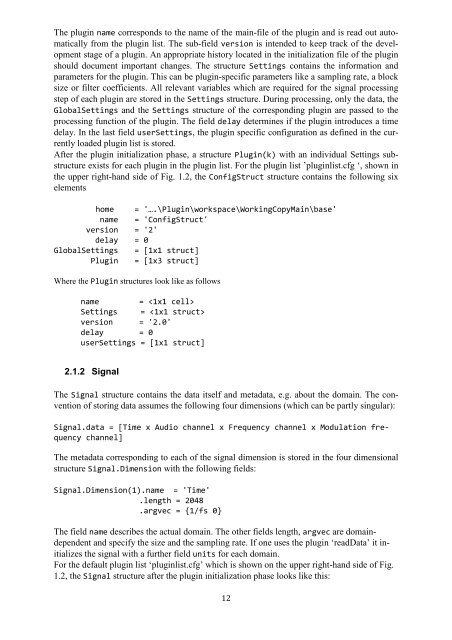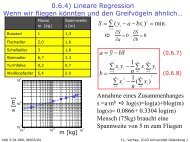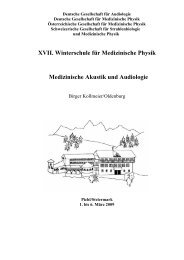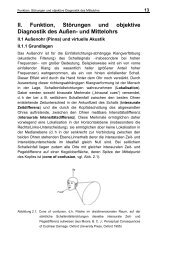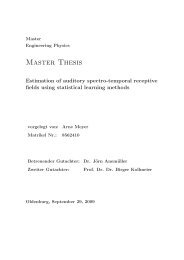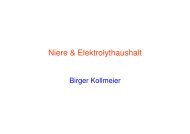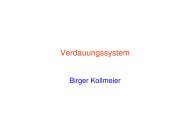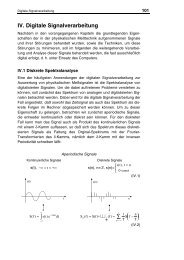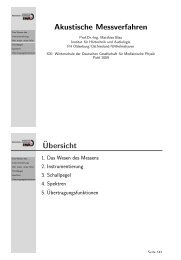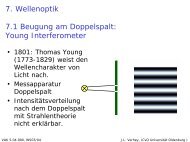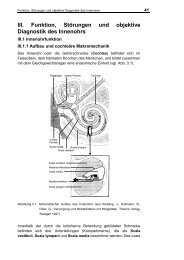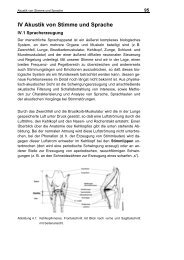PlugInChain documentation - Universität Oldenburg
PlugInChain documentation - Universität Oldenburg
PlugInChain documentation - Universität Oldenburg
You also want an ePaper? Increase the reach of your titles
YUMPU automatically turns print PDFs into web optimized ePapers that Google loves.
The plugin name corresponds to the name of the main-file of the plugin and is read out automatically<br />
from the plugin list. The sub-field version is intended to keep track of the development<br />
stage of a plugin. An appropriate history located in the initialization file of the plugin<br />
should document important changes. The structure Settings contains the information and<br />
parameters for the plugin. This can be plugin-specific parameters like a sampling rate, a block<br />
size or filter coefficients. All relevant variables which are required for the signal processing<br />
step of each plugin are stored in the Settings structure. During processing, only the data, the<br />
GlobalSettings and the Settings structure of the corresponding plugin are passed to the<br />
processing function of the plugin. The field delay determines if the plugin introduces a time<br />
delay. In the last field userSettings, the plugin specific configuration as defined in the currently<br />
loaded plugin list is stored.<br />
After the plugin initialization phase, a structure Plugin(k) with an individual Settings substructure<br />
exists for each plugin in the plugin list. For the plugin list ’pluginlist.cfg ‘, shown in<br />
the upper right-hand side of Fig. 1.2, the ConfigStruct structure contains the following six<br />
elements<br />
home = '….\Plugin\workspace\WorkingCopyMain\base'<br />
name = 'ConfigStruct'<br />
version = '2'<br />
delay = 0<br />
GlobalSettings = [1x1 struct]<br />
Plugin = [1x3 struct]<br />
Where the Plugin structures look like as follows<br />
name = <br />
Settings = <br />
version = '2.0'<br />
delay = 0<br />
userSettings = [1x1 struct]<br />
2.1.2 Signal<br />
The Signal structure contains the data itself and metadata, e.g. about the domain. The convention<br />
of storing data assumes the following four dimensions (which can be partly singular):<br />
Signal.data = [Time x Audio channel x Frequency channel x Modulation frequency<br />
channel]<br />
The metadata corresponding to each of the signal dimension is stored in the four dimensional<br />
structure Signal.Dimension with the following fields:<br />
Signal.Dimension(1).name = 'Time'<br />
.length = 2048<br />
.argvec = {1/fs 0}<br />
The field name describes the actual domain. The other fields length, argvec are domaindependent<br />
and specify the size and the sampling rate. If one uses the plugin ‘readData’ it initializes<br />
the signal with a further field units for each domain.<br />
For the default plugin list ‘pluginlist.cfg’ which is shown on the upper right-hand side of Fig.<br />
1.2, the Signal structure after the plugin initialization phase looks like this:<br />
12


